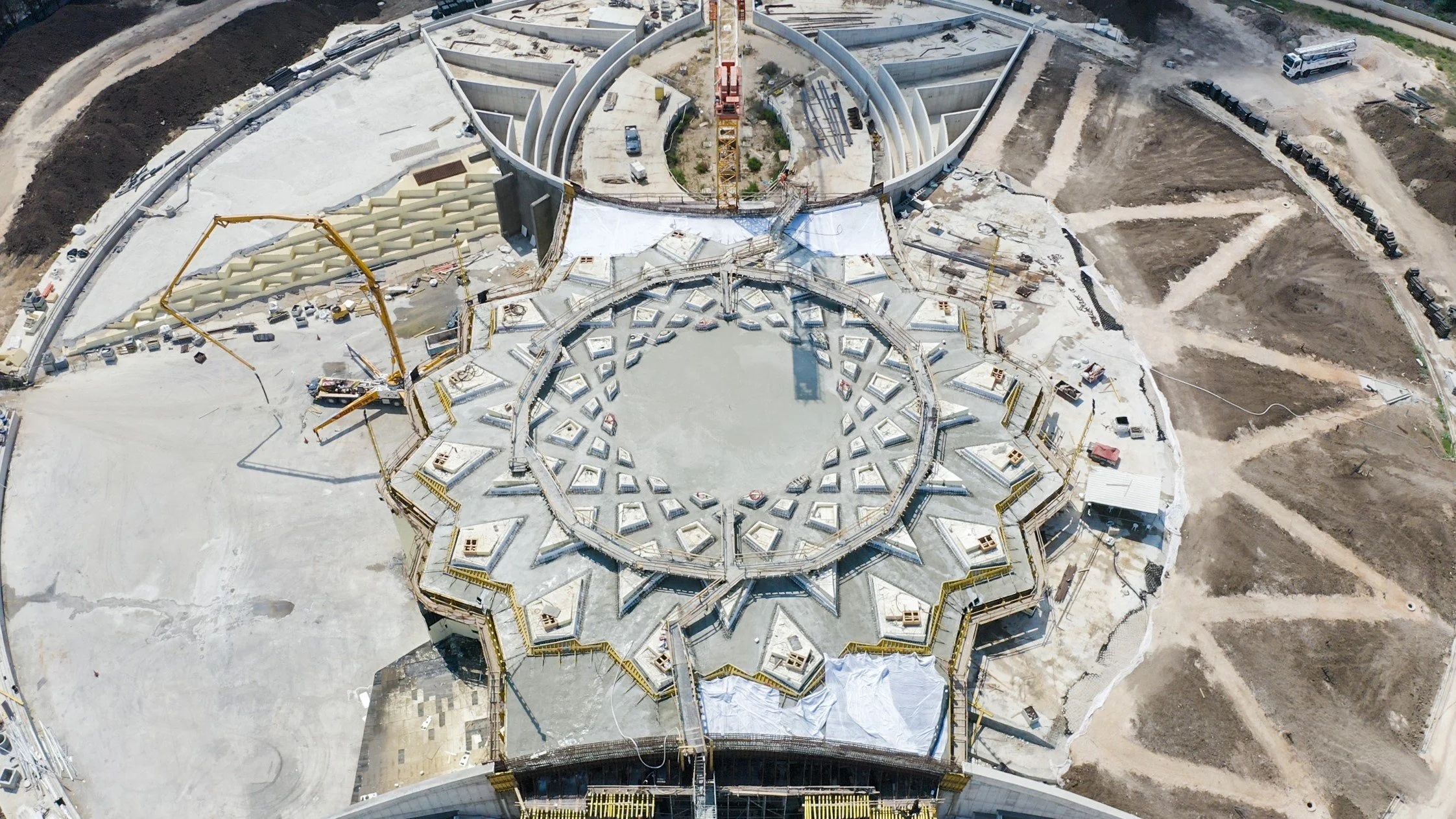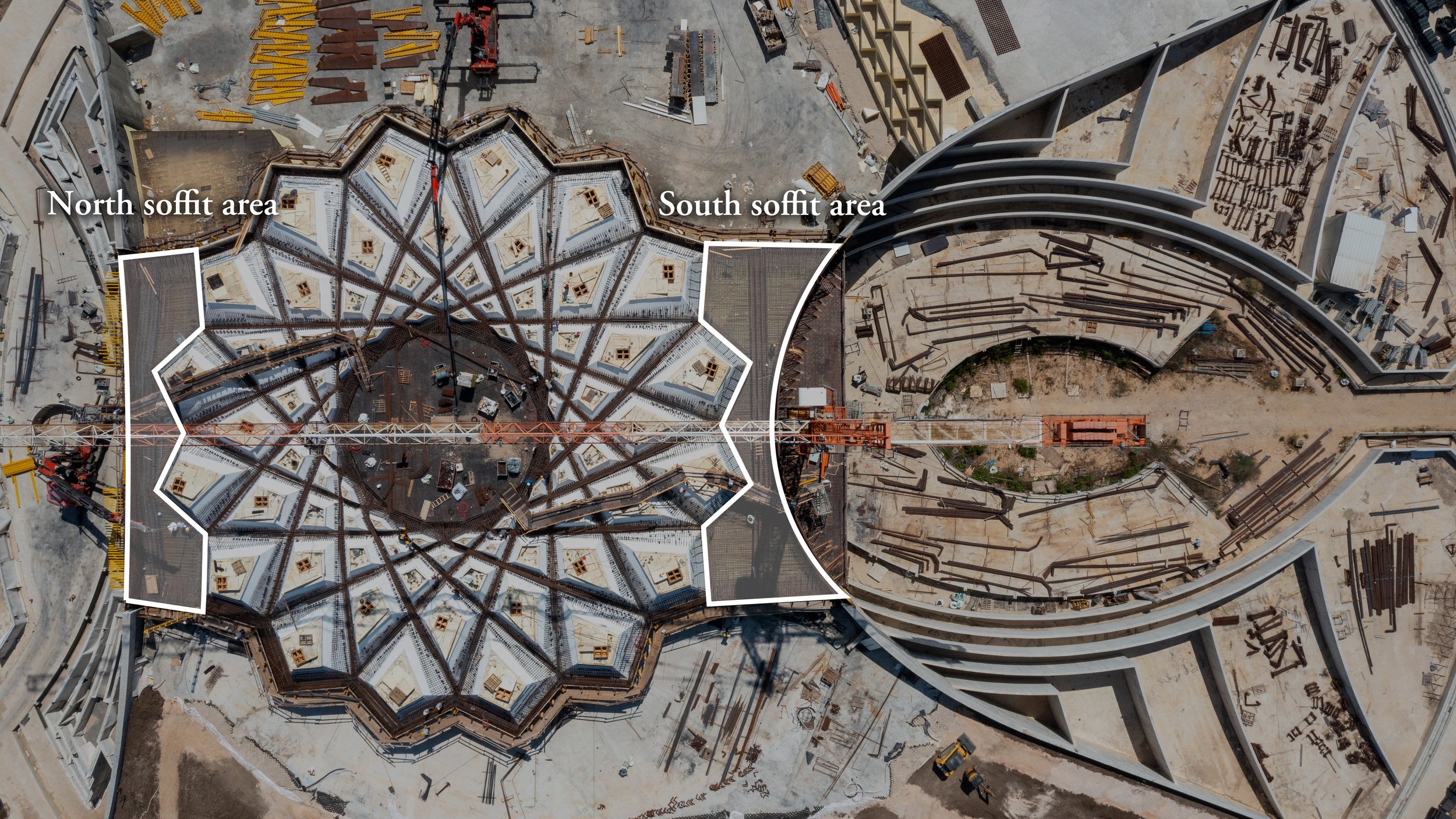Shrine of ‘Abdu’l-Bahá: Concrete structure now complete
This latest Bahá’í World News Service report on the construction of the Shrine of ‘Abdu’l-Bahá includes a video update and was published on 30 August 2023.
BAHÁ’Í WORLD CENTRE — After tireless and meticulous effort, a much-anticipated milestone has been reached—the construction team has completed the pouring of the concrete for the trellis of the Shrine of ‘Abdu’l-Bahá. This marks not only the end of one of the project’s most technically challenging aspects but also the culmination of work on the Shrine’s concrete structure.
The team had initially planned to pour all the concrete for the trellis—the intricate roof structure that now spans the central plaza and edifice—all at once. However, in mid-August, they decided to first pour the high-quality white concrete into the north and south soffit areas.
The white architectural concrete, with its textured surface, is chosen for its visibility from the plaza, while the grey concrete remains unseen.
The white, architectural concrete was poured in mid-August at the north and south soffit areas of the trellis.
White architectural concrete is poured over the rebar on the north soffit area of the trellis.
On the evening of Sunday, August 27, the team initiated the pouring of the grey concrete, a task that continued for 19 hours non-stop. Throughout the night and into the following day, it was necessary to ensure a constant stream of concrete during that period to achieve a monolithic structure with no joints.
Khosrow Rezai, the project manager, explained that this “required four pumps at the same time strategically placed in different locations.”
Amnon Cohen, the general contractor, described the complexity of this task: “It was a huge challenge to coordinate the four pumps so that they didn’t interfere with each other.”
To manage this, the trellis was segmented into four quadrants, each with a dedicated team. “Every team had a pump, and a sector to deal with,” Mr. Cohen further elaborated, “and there was a special way to cast the structure because the concrete had to be cast in a way that the curves and the corners of the EPS mold could be penetrated.”
Another challenge was ensuring a steady flow of concrete at each pump. Mr. Cohen explained: “We had to coordinate all of the trucks that enter the gate so that they would know where to go, which pump to go to, and to make sure that there were not too many trucks at one pump and too few at another. It was always truck after truck at each pump, and the amount of concrete was balanced between them, so that the ceiling could be cast homogenously.”
To ensure an uninterrupted supply of concrete, the team coordinated deliveries from four different plants. This approach was necessary because the required volume could potentially surpass what any single concrete plant might produce in a 24-hour period. Another consideration was minimizing the impact of traffic delays from any given plant. After consulting with the concrete companies, the team selected a day when they anticipated the least traffic, and minimal potential for delays.
Mr. Cohen described how the team had prepared for every situation: “We had spare equipment for everything, even a concrete pump. We organized ourselves very well so that there was nothing that could surprise us. We made a checklist of all the critical failures that could happen, and we made a plan.”
The spirit on site was charged with anticipation and excitement throughout the process. On Monday morning this week, Mr. Cohen described how everyone was feeling:
“We achieved our goal. So, everybody is very, very happy, even if they are tired. And the spirit on the site is very unique. For four years, something in the air here, on the site, makes people want to succeed, want to do the best job that they can. They see that this is a unique structure that you can create once in a lifetime.”
Rafi Anunu, principle structural engineer, described some of the unique challenges of working on this project:
“All the buildings that we usually design are built to last for 50 years. This building is designed to last hundreds of years. So this needs a different mixture of concrete. It means that the minimum diameter for the rebar is larger. Everything is different. This is not the same as other buildings.”
The concrete of the trellis will now cure for a minimum of 30 days before the formwork underneath it is removed, revealing the completed roof structure for the first time.
Meanwhile, work has already begun to complete the east berm, now that it is no longer needed as a staging area for pouring the concrete. Work is also moving ahead swiftly on the ‘Akká Visitors’ Centre, with its structure now complete and work beginning on the interior.
In the video below, Mr. Rezai describes the next steps that will follow the completion of the concrete structure of the Shrine.
To read the story online and view more photos visit news.bahai.org [https:news.bahai.org/story/1691/]
To sign up for email updates from BWNS, see their subscription page.
Photos and video on this page are from Bahá’í World News Service (BWNS) (copyright © Bahá'í International Community).
Feature image: The roof is now cast.








